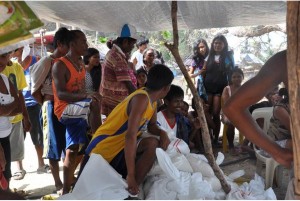
Coron, Palawan – From afar, the island of Barangay Malawig is a picture of an apocalypse. Aboard a tiny boat, upon reaching the shore of the island, one can gain a better perspective of the kind of strength Typhoon Yolanda had.
Indescribable.
It was a moving canvass. The elements of nature took wrath to a higher degree and pounded the island to rubbles. A closer look will reveal walls and roofs of houses effortlessly peeled off, schools and stores hammered to pieces, and livelihoods mercilessly vanished to bits – an instant paralysis brought by ‘Yolanda’. At every turn, pain manifests itself on faces of people who survived destruction. Behind every fallen home are layers of stories after stories, told and retold, but the gravity of pain is unchanged.
Emma Kapian, 30, one of the residents of Barangay Malawig lost her twin. Her experience of survival can be traced in tracks of tears that languidly fall on her face upon recalling her experience.
Her story was told many times over, and the freshness of pain can break the coldest of hearts.
Embattled
It was seven in the night and storm surge swiftly seeped through the house of Emma. Her knees trembled as she hurriedly clutched her 3-day old twins on each arm to escape the rising ocean that was engulfing the island. Her husband, Senkaji, carried their eldest daughter Mary Jill, and salvaged a few household items and ran.
“Ang lakas ng hangin, at talagang hindi pa namin naranasan ‘yung ganun kalakas na hangin, pero sabi ko, kahit hinang-hina na ako, kailangan talaga naming manakbo pataas ng bundok kasi mabilis ang pagtaas ng tubig at malakas ang alon (The wind was strong, something we had never experienced before, but I had to collect all energy I had left for we have to climb up the hill as quickly as we can to beat the rising water),” recalled Emma.
With what was left of her energy, she, along with her husband and Mary Jill, climbed up a hill adjacent to their house.
“Masakit po ‘yung mga bato sa paa kapag nayayapakan, pero akyat pa rin po kami (The rocks we’re stepping on were rough and painful to our feet but we kept moving anyway),” she explained.
The winds and churning waves were smashing their bodies to the hill, but the Kapians steadily climbed barefoot until they found a safe spot.
“Nu’ng naramdaman na naming medyo mataas na kami e huminto na kami (As soon as we felt that we’ve reached higher grounds, we settled),” relayed Senkaji.
High above ground, the Kapians watched Yolanda whip their house and the waves ruthlessly dragged their neighbours’ boats to the ocean.
“Para kaming nanunuod lang na sirain mga bahay namin, pero wala kaming magawa. Mahirap pang kalaban ‘yung hangin (It was like we were just watching our house get destroyed, but we cannot do anything. The winds were just strong),” said Emma.
The Agony of Emma
The strong wind stretches Emma’s energy to drain, but she had mustered a power to wrap her twins in blanket and attempted to keep them from getting soaked in heavy rain. She held her twins dearly, and prayed that they pass through the storm unharmed.
Eventually, the wind subsided.
As ocean water levelled to the ground, the magnitude of destruction showed its face. It was a crashing image of a pitiless devastation.
The whole of Malawig cried in mourning of lost houses, livelihoods and a community in general. It was as if someone had lifted the whole barangay to dizzying heights and dropped it at staggering speed and left whatever is erected to falter.
Emma was astonished. In her hands were hard, cold bodies of her twins. Their lips turned purple. She shook both babies and pressed her ear to their chests. Their heart had stopped beating. They were dead.
“Para akong dinagukan ng malakas sa likod, hindi po ako nakaiyak kaagad (It felt like a strike in the back, and I can’t even cry),” said Emma in a trembling voice.
She looked to Senkaji and Mary Jill, and broke down.
“Tinignan ko ulit, baka buhay pa, pero matigas na sila pareho talaga, wala ng iyak (I took a second look at them to check if they are breathing, but both bodies were hard and cold, and I they are not crying anymore),” she said crying.
As Emma looked down, she saw the enormity of damage caused to their barangay. Her emotions were torn, and her heart cried for the loss of her home, her livelihood and her children.
Senkaji tightly embraced Mary Jill and Emma, as he himself shed tears.
“Okay lang sana kung bahay lang at ‘yung bangka ang nasira e, pero ang pinakamasakit, nawala pa ‘yung kambal namin (I could have easily accepted the loss of our house and boat, but the most painful to accept was the loss of my twin),” said Senkaji, whose boat for fishing was destroyed as well.
“Ngayon po, kabuhayan namin wala na din, aasa na rin muna sa relief (Now our livelihood has vanished too we will try to survive throught the relief goods ),” Senkaji added.
They used to earn a maximum of P25,000 a month from fishing, and have now been left without an option for income.
Undreamt of
In the aftermath of the storm, help and support flooded barangay Malawig.
DSWD-Field Office IV-B attended to the needs of typhoon-devastated barangays and delivered relief to its residents.
There were 160 houses in the area and all of which were damaged if not swept away completely.
Today, rehabilitation, debriefing of victims and rebuilding of houses are ongoing.
Various organizations have converged to hasten the restoration of damaged houses and provide support to residents who have lost their livelihoods.
The International Labor Organization (IOM) had made their full assessment of Malawig and will implement an income-generating activity as temporary livelihood for the residents.
Relief goods from DSWD, the British Navy, LGU of Coron and other non-government organizations have been distributed to all residents. All efforts that have been done by far are progressive.
“Hindi po talaga kami makapaniwala na ganito ang aabutin namin, wala pa kaming ganitong karanasan noon (We could not believe this would happen, we had never had this before),” said Emma.
“Pero wala naman magagawa kundi bumangon (But we can’t do anything but rise above it),” she added, in hope of rising from the catastrophe.
The other cheek
The island-strip of Malawig is situated off the farthest end of the northern coast of Palawan. Even after Yolanda had hit the barangay, the shoreline is as majestic and breathtaking as it ever was. If you stand by the shore and look over the sea, and away from the destruction caused by Yolanda, it becomes a refreshing beauty that seemingly cleanses the pain of looking at typhoon-pounded community of Malawig.
The stark contrast is an apparent message of nature, that misery and beauty sit side by side to each other. A person can always turn around, to see vibrancy, to shake up a perspective and lead the eyes to a brighter, more pleasing blue beyond.
Emma buried her twin under their reconstructed hut. Her story will be told and retold and the gravity of pain will gradually subside in time. Her eyes may have cried tons of tears, but her spirit is indestructible.
“Babangon ulit, baka may planong iba ang Diyos sa amin (We will rise from this, maybe God has a different plan for us), “ she said, while forcing a faint smile.
The most honest of emotions is pain. It easily manifests itself on the face of a human being. It tells a story – of heartbreak, losing a loved one, a home and a life you once knew. Pain lingers and clings to the heart until the agony settles and fades into memory. The mightiest of strength, however, is drawn from the greatest pains ever inflicted. No matter the kind of catastrophe ever ruin a person’s life, hope, and will to survive can endure supreme emotional pain.
Emma had lost her twin, but her transcendent optimism fuses peace to her mourning soul.#


